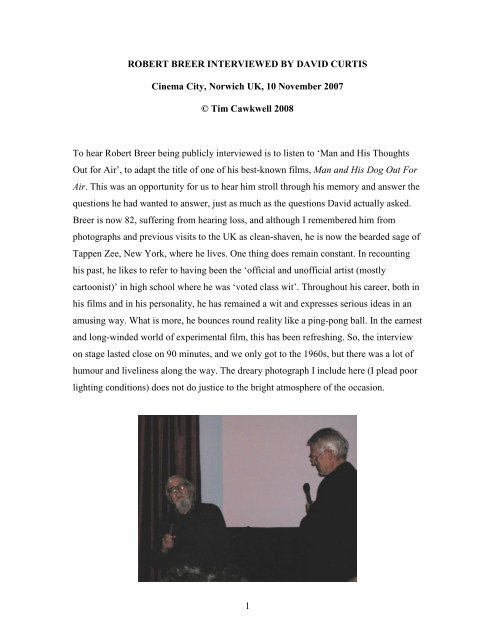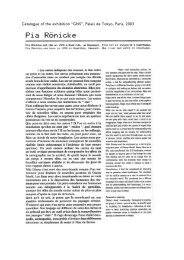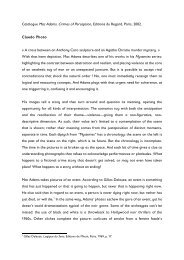1 ROBERT BREER INTERVIEWED BY DAVID CURTIS Cinema City ...
1 ROBERT BREER INTERVIEWED BY DAVID CURTIS Cinema City ...
1 ROBERT BREER INTERVIEWED BY DAVID CURTIS Cinema City ...
Create successful ePaper yourself
Turn your PDF publications into a flip-book with our unique Google optimized e-Paper software.
<strong>ROBERT</strong> <strong>BREER</strong> <strong>INTERVIEWED</strong> <strong>BY</strong> <strong>DAVID</strong> <strong>CURTIS</strong><br />
<strong>Cinema</strong> <strong>City</strong>, Norwich UK, 10 November 2007<br />
© Tim Cawkwell 2008<br />
To hear Robert Breer being publicly interviewed is to listen to ‘Man and His Thoughts<br />
Out for Air’, to adapt the title of one of his best-known films, Man and His Dog Out For<br />
Air. This was an opportunity for us to hear him stroll through his memory and answer the<br />
questions he had wanted to answer, just as much as the questions David actually asked.<br />
Breer is now 82, suffering from hearing loss, and although I remembered him from<br />
photographs and previous visits to the UK as clean-shaven, he is now the bearded sage of<br />
Tappen Zee, New York, where he lives. One thing does remain constant. In recounting<br />
his past, he likes to refer to having been the ‘official and unofficial artist (mostly<br />
cartoonist)’ in high school where he was ‘voted class wit’. Throughout his career, both in<br />
his films and in his personality, he has remained a wit and expresses serious ideas in an<br />
amusing way. What is more, he bounces round reality like a ping-pong ball. In the earnest<br />
and long-winded world of experimental film, this has been refreshing. So, the interview<br />
on stage lasted close on 90 minutes, and we only got to the 1960s, but there was a lot of<br />
humour and liveliness along the way. The dreary photograph I include here (I plead poor<br />
lighting conditions) does not do justice to the bright atmosphere of the occasion.<br />
1
This essay is not a transcript of the interview, but is put together from other published<br />
material and mostly from the notes I made at the time, a tricky exercise because Breer<br />
went back and forth, intercutting ideas, leaving some questions unanswered, and some<br />
answers unfinished, yet showing off a highly creative mind at work.<br />
First of all, let us get some biographical detail out of the way. I thought it was<br />
worth assembling the following facts from what he said that day and on other occasions:<br />
• Born 1926<br />
• Father was engineer in Detroit car industry (and designer of the Chrysler Airflow<br />
automobile in 1934)<br />
• ca 1936, went to art classes at the Detroit Institute of Art<br />
• to Stanford in 1943 to study engineering<br />
• Played high-school football and captained the team in 1943<br />
• First acquaintance with fine art through mother of a friend (what year?)<br />
• Around 1944, he switched at college from engineering to art<br />
• Drafted into US Army from 1945 to 1947<br />
• Returned to Stanford in 1947 and had first exposure to Mondrian on a trip to San<br />
Francisco<br />
• Graduated in 1949, spent three years in Paris under the GI Bill (having crossed<br />
the Atlantic on a small freighter), and apparently in Paris for most of 1950s<br />
• First film Form Phases in 1952<br />
• 43 films between 1952 and 2003.<br />
The facts provide a framework for understanding how Breer became a creative artist.<br />
Two strands are apparent from the beginning. The first is the cartooning one. He liked<br />
drawing with charcoal early on, a medium which allows rapid execution and the deft<br />
sketching necessary for suggesting shapes and movement. Secondly, it seems to me that<br />
his father’s engineering talent – all articles like to mention his father’s work for Chrysler<br />
– was important in giving him an inherited talent for studio practice that used mechanical<br />
know-how to eliminate as much of the boring part of animation as possible, for example a<br />
device to move a drawing into position on the lightbox. It also must have contributed to<br />
Breer’s interest in machinery in his films, for example the rotating pole in 69, and more<br />
2
significantly still in the machinery of optics: experimenting with how we perceive things<br />
on screen. His father’s hobby was photography and his experimenting bent led him to<br />
invent a camera for making 3D movies (to watch them ‘you had to sit upright’). This<br />
created an interest in the intersection between photography and the physical world.<br />
Something turned Breer on to abstract art in the 1940s, and he often cites the visit<br />
to the Mondrian exhibition in San Francisco in the late 40s. Although his art teachers<br />
were all figurative, after the Mondrian experience he made an abstract painting -- which<br />
was turned against the wall in disapproval. He was rescued by the Head of Humanities<br />
who ‘set me up in a faculty studio to paint as I wished with a young art faculty teacher to<br />
check on me once a week or so’ [as he explained to Fred Camper]. Living in Paris, he fell<br />
in with Victor Vasarely (pure abstractionist), Hans Arp (explorer of the operation of<br />
chance) and Jean Tinguely (who delighted in machinery in motion). In connection with<br />
the artists devoted to pure abstraction, he said that they had an ‘almost religious devotion<br />
to the operation within the frame’ adding that avant-gardism was much formalized in<br />
Paris, so that every show had to have a manifesto, an idea to which Breer was himself<br />
resistant. This is an intriguing contrast between the ideological purity of the Europeans<br />
(‘they were all Communists’) creating only within a theoretical framework, and the<br />
practical, pragmatic American.<br />
It is clear that Paris was a good place for Breer to be. Beside the ferment in the<br />
gallery world, it provided an opportunity to see work from the film avant-garde as well<br />
(which would not necessarily have been true if, say, he had been in London): Ruttmann,<br />
Eggeling, Richter, Léger. But he did not lose sight of the comic tradition either: seeing<br />
the early animation of Émile Cohl had an impact as well (this was in the late 1950s, after<br />
he had made Man and His Dog Out For Air), for its whimsy and for its exploitation of<br />
the spontaneous transformation that film can achieve, for example of a hat into a bird.<br />
Breer’s first film, Form Phases, made in 1952, was preceded (if I understood this<br />
correctly) by what seems to have been a significant moment, when returning to Michigan<br />
from Paris, he nailed a camera (still? movie?) to a door in order to fix it, and took a<br />
sequence of images. Also, referring to the time of the Mondrian exhibition and therefore<br />
presumably to his own early work as a painter, Breer said he had made sketches of the<br />
stages of a painting, put them on cards and then flipped through them. These ideas then<br />
3
fed into Form Phases, which moved abstract shapes around in a frame, and spawned<br />
three other works, which now comprise Form Phases I to IV. But he seems to have<br />
wanted to move forward from this. When David Curtis asked him why he stopped<br />
making abstract films and went onto something else, Breer referred to the way he got<br />
interested in the act of looking at a painting: do you need just to glance at it or absorb it<br />
through a stare? This could be widened into how we perceive events: do they happen<br />
consecutively, or in fact do they happen simultaneously? Surrealism, which seeks to<br />
create a different kind of narrative through incongruity, to reveal a hidden narrative, was<br />
not of interest, as he ‘had got into painting as a discipline to avoid narrative’. What he<br />
wanted was to apply plastic ideas solely, i.e. the fact that one image could be interrupted<br />
by another, or as Marshall McLuhan characterized it, the fact that perception could be<br />
simultaneous rather than linear. When David asked whether he was interested in the idea<br />
of a ‘stream of consciousness’, or using free association, Breer was prepared to admit that<br />
possibly this was right, but that the important thing was to get away from narrative<br />
continuity, to sequence images ‘against narrative in order to preserve plastic qualities’.<br />
For their time, these ideas were very new. Breer referred to his ‘first stumbling<br />
effects’ (presumably Form Phases I-IV and Image by Images I-IV), before he made a film<br />
‘that really excited me’. This was Recreation (1956), only two minutes long, but in effect<br />
a ‘collage’ of hundreds of different images. (As he told Jim Trainor, ‘I wanted something<br />
that would stroke the retina a little more.’) A follow-up film (presumably Recreation II)<br />
he felt was dead, and linked that with a comment on his aim to be unpredictable<br />
throughout his career. In 1957, Man and His Dog Out For Air showed Breer in much<br />
more linear form, albeit in a very free way, which he described as an antidote to his more<br />
‘congested’ films. But having made Recreation, he did return to those ideas in 1961 in<br />
the film Blazes. This film takes 100 different images painted in gouache on individual<br />
cards which were then scattered on the floor. When they were gathered into a pack, Breer<br />
found he could flip through them, see how they reacted to one another, and amend the<br />
order. In talking of this process, he referred to the precedence of the Dadaist, Hans Arp,<br />
who dropped pieces of paper on the floor and then fixed the collage according to how<br />
they fell. ‘I was repeating Arp.’ This linked to a broader point about his inspiration: the<br />
4
application of chance operations where you did not know the outcome was very<br />
important to him.<br />
If there is a unique fact about Breer’s technique it is surely being the first to use<br />
blank index cards, a ‘very practical’ solution to how to produce his kind of animation.<br />
While Man and His Dog was done on typewriter sheets with holes punched so that each<br />
sheet fitted on a peg, this was comparatively laborious. Index cards he realized were stiff<br />
enough both to fit an exact position on the light box, and to be flipped through by hand in<br />
order to test sequences. When you are doing ‘animation by oneself, you need to<br />
simplify’. These practices seem to have remained crucial throughout his career. Referring<br />
to Gulls and Buoys (1972), he said he was exploring how rapid changes of colour led to<br />
new combinations, and importantly, he ‘changed the dosage of colour’ by filming each<br />
image in two frames rather than just one. So, two frames of red followed by two of green<br />
created a ‘schizophrenia in the retina’, an effect unique to cinema. I asked whether he<br />
regretted not having the personal computer available to him which would have been well<br />
suited to the ideas he was exploring in the 50s and 60s, to which he gave the robust<br />
answer that life was too short for regrets of that kind.<br />
The final strand to be mentioned in the work of this period is that Breer rose to<br />
prominence as part of the American film avant-garde, although his friends such as Claes<br />
Oldenburg and Roy Lichtenstein were mostly in the art world. In recalling his efforts to<br />
make a bridge between his film work and the gallery world (where the rewards for<br />
success were significant), Breer gave vent – without bitterness that I could detect – to a<br />
certain frustration and recalled how Hilton Kramer, the noted art critic, refused to write<br />
about his films because they moved, while the film critics who wrote about narrative<br />
cinema would not write about his films, because ‘they could not write about painting’.<br />
Breer’s forty-three films have been made over a fifty-year period. This is a very<br />
substantial body of work, not in terms of screen time, but because so many things are<br />
crammed into the films: like looking down a microscope. Breer commented that there are<br />
not more because there was a risk of losing enthusiasm for the creative act. One particular<br />
pleasure of seeing the films and hearing him talk was to realize that the enthusiasm was<br />
still intact.<br />
5
Sources<br />
• List of films on www.imdb.com<br />
• ‘Aurora 2007: Possible Worlds’ – catalogue to accompany Aurora Film Festival<br />
in Norwich, November 2007, edited by Adam Pugh. See www.aurora.org.uk,<br />
where this can be purchased online. Includes an article by Fred Camper and an<br />
interview with Robert Breer from 1980 by Jim Trainor.<br />
• Online article by Jackie Leger ‘Robert Breer: Animator’ – go to www.awn.com<br />
(and go to: /mag/issue1.4/articles/breer1.4.html).<br />
6




